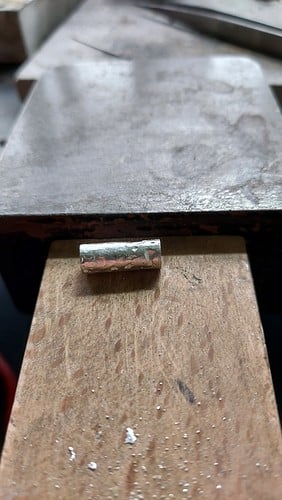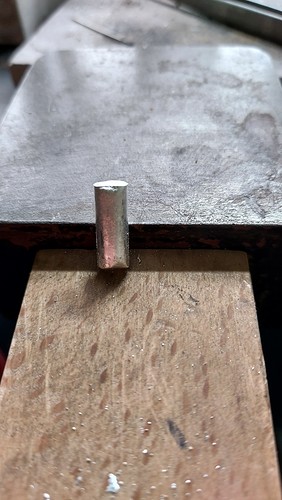Hi Andrew,
I have made ingots using the same kind of reversible steel ingot mold you are describing since I was apprenticed many moons ago. From my experience ingots can have imperfections that manifest themselves in two ways: an indent where there is a pocket that goes into the ingot, and a bubble protruding up from the surface of the ingot. From your pictures it looks like the ingot is “dented” inward. There are usually some simple reasons for either, and therefore simple solutions for them as well.
If during the process of melting the metal in a crucible you are adding borax while heating the metal - and I hope you are because it helps “clean” the metal by capturing any impurities that may have found their way into your melt, then if too much borax is used this can make its way into the ingot mold along with the metal. The borax liquifies as it and the metal are heated and it floats around on the top of the molten metal. As the molten metal is swirled around in the crucible for a moment or two the borax collects the impurities/dirt that may be present. Usually is sluffs off and stays in the crucible. But sometimes a bit of it will pour out with the metal into the form. In my experience the borax has always stayed on the surface of the ingot and not infiltrated. The borax will dissolve in water, so when this happens to me, I just put it in my pickle solution for a few minutes. No harm, no foul since I’m going to be rolling the ingot anyway. I also always do some forging of the ingot before rolling because it helps prevent the possibility of the ingot cracking while rolling.
If the ingot has a bump protruding outwardly from the surface, then some gas(es) have been trapped internally in the ingot. When I see this, I just re-melt the metal and make sure I swirl it around in the crucible again with a little pinch of borax to get rid of any possible impurities and re-pour my ingot. In almost every instance the second ingot comes out fine.
As for using a release in the ingot mold, I don’t use oil. Mainly I just dislike the smoke and smell that comes off the ingot mold when it is heated. I use carbon. Graphite will work as John mentioned, but I use a different type of carbon that is more readily available: soot from my torch. Carbon is a great lubricant, so after I heat the mold to remove all the moisture trapped in the steel (very important!), I coat the surfaces of the mold that will be touching the ingot with soot from my torch by using a fuel only (yellow) flame. A fuel-only acetylene torch flame is very sooty, but even a propane fuel-only flame produces soot and will work. The main benefit of “carboning” up the surfaces of your ingot goes beyond just being a mold release; it also creates a reducing atmosphere a bit as you pour your metal into the form. Carbon absorbs oxygen (“reducing atmosphere”), oxygen when it mixes with metal creates oxides which can penetrate the surface of the ingot as it cools and cause a “staining” of your metal. This staining is also sometimes referred to as fire scale. It is difficult to see if this staining has happened on a newly minted ingot because it has a rough surface on it which I call a casting “skin”. I always smooth the surface of the ingot by filing, sanding, and doing a bit of polishing on the ingot before I continue. This really the only way you will be able to see if the ingot has this oxide staining issue. It doesn’t need to be like a finished polish. If an ingot has staining due to oxides infiltrating the surface, then I just re-melt and re-pour because the staining will continue to manifest itself as you process the ingot by rolling, drawing, forging, etc. Better to put a little time it at the beginning and have a good clean ingot at the start, than to “discover” the fire staining after the jewelry piece is made and you are polishing it up only then discovering the oxide stain. Been there. Done that.
Rio Grande has a really good video on ingot making that will explain all this as well.
Sorry for the length of this response, but I wanted to by thorough. Well begun is half done.
Best of luck with making your ingots,
Mike

